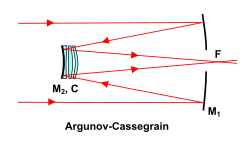Argunov–Cassegrain telescope

The Argunov–Cassegrain telescope is a catadioptric telescope design first introduced in 1972 by P. P. Argunov.[1][2] All optics are spherical, and the classical Cassegrain secondary mirror is replaced by a sub-aperture secondary corrector group consisting of three air-spaced elements, two lenses and a Mangin mirror (the element farthest from the primary mirror).
Discussion
[edit]Argunov systems only employ spherical surfaces and avoid the practical difficulties of making and testing aspheres. However, this benefit is marginal, as it is almost as difficult to make a true zone-free sphere of precise radius of curvature as it is to make an aspheric surface with comparable precision.[citation needed] Further, since multiple surfaces are involved, creating a design with good aberration correction can become very complicated.[3]
See also
[edit]References
[edit]- ^ Argunov, P.P. (1972). "Izokhromaticheskie sistemy teleskopov so sfericheskoi optikoi" [Isochromatic telescope designs with spherical optics]. Astronomicheskij Vestnik. 6 (1): 52–61.
- ^ "Catadioptric telescopes". Sky Gazette. 6 March 2016. Retrieved 19 February 2018.
- ^ Sacek, Vladimir. "Catadioptric telescopes". telescope-optics.net. Notes on amateur telescope optics. 10.2.1.
Further reading
[edit]- Kudzej, I.; Karetnikov, V.G.; Dubovsky, P.A.; et al. (2007). "Astronomical observatory at Kolonické Sedlo and its results in variable stars observing". Odessa Astronomical Publications. 20: 100–105.
- Kudzej, I.; Dubovsky, P.A. (December 2010). "One-meter telescope in Kolonica Saddle – 4 years of operation" (PDF). Odessa Astronomical Publications. 23: 70–73. Bibcode:2010OAP....23...70K – via Harvard U. ADS.
External links
[edit]- "Astrokolonica page". Archived from the original on 30 May 2014.
- "Astronomical Observatory on Kolonica Saddle". Archived from the original on 8 June 2016.
